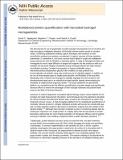| dc.contributor.author | Appleyard, David C. | |
| dc.contributor.author | Chapin, Stephen C. | |
| dc.contributor.author | Doyle, Patrick S. | |
| dc.date.accessioned | 2013-06-06T17:26:39Z | |
| dc.date.available | 2013-06-06T17:26:39Z | |
| dc.date.issued | 2010-12 | |
| dc.identifier.issn | 0003-2700 | |
| dc.identifier.issn | 1520-6882 | |
| dc.identifier.uri | http://hdl.handle.net/1721.1/79069 | |
| dc.description.abstract | We demonstrate the use of graphically encoded hydrogel microparticles for the sensitive and high-throughput multiplexed detection of clinically relevant protein panels in complex media. Combining established antibody capture techniques with advances in both microfluidic synthesis and analysis, we detected 1−8 pg/mL amounts of three cytokines (interleuken-2, interleuken-4, and tumor necrosis factor alpha) in single and multiplexed assays without the need for filtration or blocking agents. A range of hydrogel porosities was investigated to ensure rapid diffusion of targets and reagents into the particle as well as to maintain the structural integrity of particles during rinsing procedures and high-velocity microfluidic scanning. Covalent incorporation of capture antibodies using a heterobifunctional poly(ethylene glycol) linker enabled one-step synthesis and functionalization of particles using only small amounts of valuable reagents. In addition to the use of three separate types of single-probe particles, the flexibility of the stop-flow lithography (SFL) method was leveraged to spatially segregate the three probes for the aforementioned target set on an individual encoded particle, thereby demonstrating the feasibility of single-particle diagnostic panels. This study establishes the gel−particle platform as a versatile tool for the efficient quantification of protein targets and significantly advances efforts to extend the advantages of both hydrogel substrates and particle-based arrays to the field of clinical proteomics. | en_US |
| dc.description.sponsorship | National Institute of Biomedical Imaging and Bioengineering (U.S.) (Grant R21EB008814) | en_US |
| dc.description.sponsorship | Ragon Institute of MGH, MIT and Harvard | en_US |
| dc.language.iso | en_US | |
| dc.publisher | American Chemical Society | en_US |
| dc.relation.isversionof | http://dx.doi.org/10.1021/ac1022343 | en_US |
| dc.rights | Article is made available in accordance with the publisher's policy and may be subject to US copyright law. Please refer to the publisher's site for terms of use. | en_US |
| dc.source | PMC | en_US |
| dc.title | Multiplexed Protein Quantification with Barcoded Hydrogel Microparticles | en_US |
| dc.type | Article | en_US |
| dc.identifier.citation | Appleyard, David C., Stephen C. Chapin, and Patrick S. Doyle. Multiplexed Protein Quantification with Barcoded Hydrogel Microparticles. Analytical Chemistry 83, no. 1 (January 2011): 193-199. | en_US |
| dc.contributor.department | Massachusetts Institute of Technology. Department of Chemical Engineering | en_US |
| dc.contributor.mitauthor | Appleyard, David C. | en_US |
| dc.contributor.mitauthor | Chapin, Stephen C. | en_US |
| dc.contributor.mitauthor | Doyle, Patrick S. | en_US |
| dc.relation.journal | Analytical Chemistry | en_US |
| dc.eprint.version | Author's final manuscript | en_US |
| dc.type.uri | http://purl.org/eprint/type/JournalArticle | en_US |
| eprint.status | http://purl.org/eprint/status/PeerReviewed | en_US |
| dspace.orderedauthors | Appleyard, David C.; Chapin, Stephen C.; Doyle, Patrick S. | en_US |
| mit.license | PUBLISHER_POLICY | en_US |
| mit.metadata.status | Complete | |
